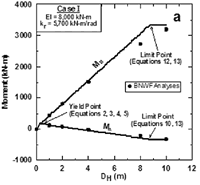
| Project Title/ID Number | Workshop on Simulation and Seismic Performance of Deep Foundations—2372003 |
| Start/End Dates | 10/1/03—9/30/04 |
| Project Leader | Ross Boulanger (UCD/F) |
| Team Members |
F=faculty; GS=graduate student; US=undergraduate student; PD=post-doc; I=industrial collaborator; O=other
Click on images to enlarge in a new window
The proposed workshop will be the culmination of a comparative evaluation of emerging design methods for pile foundations in liquefied ground. The overall goals are as follows:
This workshop supports PEER's efforts toward developing performance based design methodologies for bridge and building systems by addressing a problem that is of strong interest to owners and a major source of uncertainty in current design and assessment practices.
The coordinated plan of these efforts is proceeding as follows:
In addition to planning of the workshop, some initial comparisons of design methodologies have been performed. The figure below shows results of one such comparison. This figure compares results of a limit equilibrium approach by Dobry et al. (2003) and a Beam on Nonlinear Winkler Foundation approach by Brandenberg (supported under project 2312003). The comparisons are for two different pile foundations having very different lateral stiffness', and show that these two different approaches are capable of producing very comparable results for the deflections and bending moments induced by lateral spreading of a non-liquefied crust layer over liquefied sand.
There are no competing plans for such a workshop that I am aware of.
PEER is in a unique position to lead the establishment of engineering guidelines for the design of pile foundations in liquefied and laterally spreading ground, which is widely recognized as a major issue in earthquake engineering practice and hazard mitigation. PEER and PEER researchers have been contributed to the rapid development of our understanding of the mechanisms of soil-pile interaction in liquefied and laterally spreading ground, such as obtained through research projects funded by the PEER-core, PEER-Lifelines, Caltrans, and other organizations.
The March 2005 date of the workshop was set to avoid conflicts with other US and Japanese events, and is later than original anticipated. This requires extending this project into next year, but with no additional funding.
The major deliverable will be the workshop proceedings. I propose that the Workshop Proceedings be published as an ASCE Special Publication under joint sponsorship of the ASCE-GeoInstitute and PEER. Such an arrangement would assure the widest possible distribution. The chair of the GeoInstitute Publications Committee is receptive to this plan, and I will explore the necessary planning arrangements.